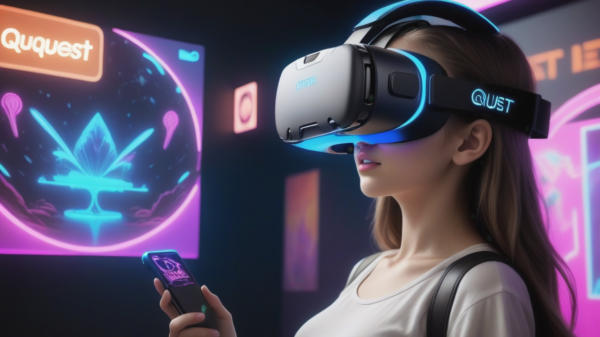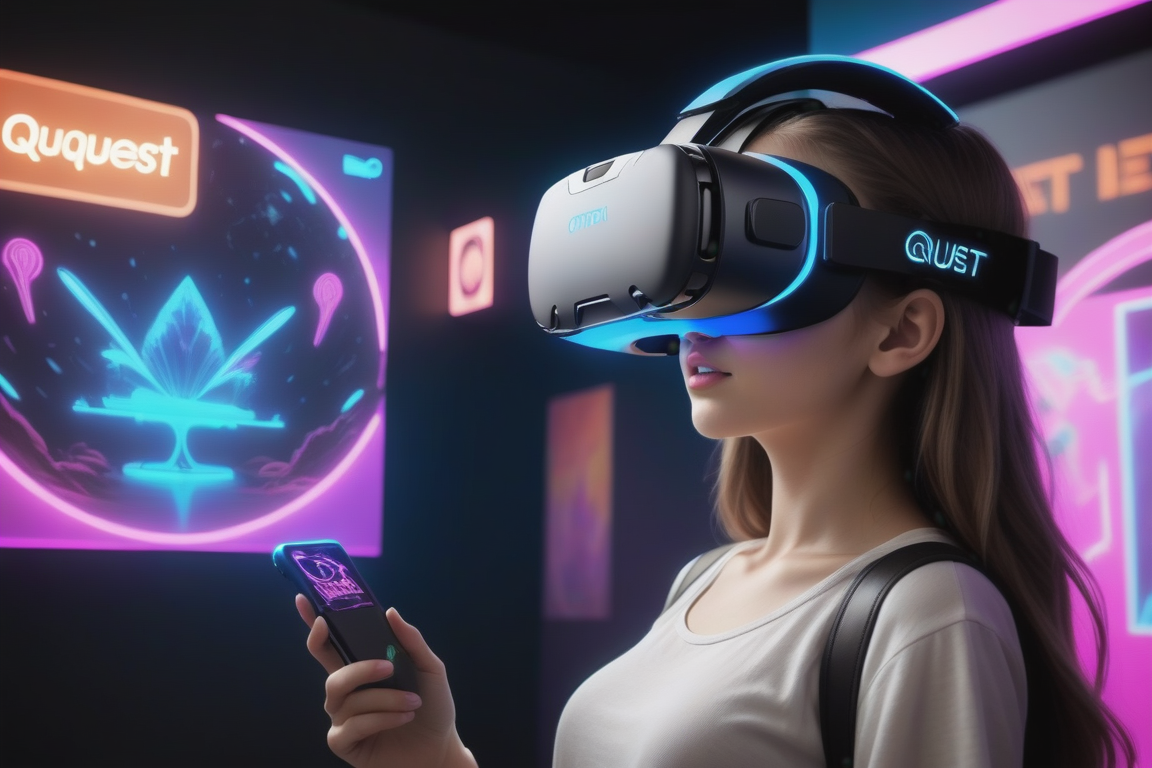A. Explanation of Metaverse Gaming
Metaverse gaming isn’t a singular experience, but rather an evolving tapestry woven from diverse threads. Imagine a futuristic fusion of traditional video games, social media platforms, and virtual reality worlds, where players connect, interact, and participate in shared digital experiences. Think open-world sandbox games like Minecraft with an extra layer of social interactivity, where customized avatars mingle, trade virtual goods, and even build sprawling digital economies. But this isn’t just about crafting pixelated blocks – the metaverse aspires to blur the line between the real and virtual. Imagine attending concerts with global friends in fully realized digital venues, owning unique NFTs linked to your in-game persona, or even earning a living through play-to-earn economies.
B. Growing Popularity and Significance in the Gaming Industry
The allure of the metaverse is undeniable. With the promise of unprecedented immersion, endless creativity, and boundless social possibilities, it’s captivating both players and industry giants alike. Traditional gaming studios like Microsoft and Sony are investing heavily in VR technology and metaverse platforms, while blockchain-based startups are pioneering play-to-earn models and decentralized virtual economies. Existing games like Fortnite and Roblox are already incorporating metaverse elements, hosting virtual concerts and interactive events that transcend conventional gameplay. This nascent industry is still finding its footing, but its potential for growth is staggering, attracting millions of users and billions of dollars in investment.
C. Overview of the Debate Surrounding its Future Potential
While the hype surrounding the metaverse is palpable, a cautious undercurrent of debate ripples beneath the surface. Critics point to potential pitfalls like technological limitations, security risks, and ethical concerns associated with virtual economies and ownership. The question of interoperability – the seamless movement of players and assets across different metaverse platforms – remains a major hurdle, potentially fragmenting the experience and undermining its immersive potential. Moreover, the integration of blockchain and play-to-earn models raises questions about accessibility and potential exploitation, particularly for younger audiences. Ultimately, the future of metaverse gaming hangs in the balance, a captivating dance between immense potential and unaddressed challenges.
This is just a brief overview of each section. Feel free to expand on each point with specific examples, statistics, and interesting case studies to deepen your analysis and make your writing even more engaging. I’m here to help you craft a compelling exploration of metaverse gaming and its impact on the industry.
II. Definition and Evolution of Metaverse Gaming
A. Brief History of Metaverse Gaming:
The seeds of metaverse gaming were sown long before the term itself took root. Early glimpses could be seen in clunky virtual worlds like Second Life (2003) and the proto-MMORPGs of the late 90s. These platforms offered a taste of online social interaction and world-building, but their clunky interfaces and limited technology hampered mass adoption. The turning point came with the rise of immersive technologies like VR and the burgeoning power of online communities. Games like Minecraft (2011) and Roblox (2006) democratized creation and collaboration, laying the foundation for user-driven virtual worlds. Then came the blockchain revolution, paving the way for play-to-earn concepts and virtual economies, further blurring the lines between play and reality. Finally, the concept of the “metaverse” surged into mainstream consciousness in 2021, propelling further investment and development in this nascent realm.
B. Definition and Characteristics of Metaverse Gaming:
Metaverse gaming transcends the confines of traditional games. It’s a constellation of interconnected virtual worlds where players experience, not just watch, a narrative. Key characteristics include:
- Persistent and Open Worlds: Unlike linear campaigns, metaverse games unfold in persistent, evolving worlds that exist even when players are offline. These worlds are often open-ended, allowing exploration, creativity, and player-driven experiences.
- Avatar-Based Social Interaction: Players interact through customized avatars, fostering a sense of identity and enabling self-expression within the virtual realm. Social interaction becomes paramount, from casual conversations to collaborative ventures and community events.
- User-Generated Content and Economies: Robust creation tools empower players to shape the world, build structures, and create unique items. Virtual economies emerge, powered by in-game currencies and even real-world assets like NFTs, blurring the line between play and economic activity.
- Interconnectivity and Interoperability: Ideally, multiple metaverse platforms will interconnect, allowing players and assets to seamlessly move between different virtual experiences, further boosting immersion and expanding possibilities.
C. Comparison to Traditional Gaming:
Compared to traditional games, metaverse gaming offers:
- Greater Agency and Freedom: Players are no longer passive consumers of pre-set stories. They actively shape the world, forge their own paths, and contribute to a dynamic, evolving ecosystem.
- Deeper Social Connection: The avatar-based interaction goes beyond text chat and voice communication. Non-verbal cues, shared experiences, and collaborative activities cultivate a more nuanced and immersive social dynamic.
- Potential for Economic Participation: Virtual economies offer novel ways to play-to-earn, own virtual assets, and even build lucrative businesses within the game world.
However, metaverse gaming also faces challenges:
- Technological Hurdles: VR technology still needs refinement, and creating truly immersive and interconnected worlds remains a technical feat.
- Accessibility and Inclusivity: Not everyone has access to expensive VR headsets or high-speed internet, potentially leaving marginalized communities behind.
- Ethical Concerns: Play-to-earn models and virtual economies raise concerns about exploitation, particularly for younger audiences.
The future of metaverse gaming is brimming with both possibilities and challenges. As technology improves, accessibility increases, and ethical concerns are addressed, this innovative form of play could reshape the entire gaming landscape.
I hope this expanded section adds more depth and context to your exploration of metaverse gaming. Feel free to ask if you have any further questions or want to explore specific aspects in more detail!
III. Advantages of Metaverse Gaming
Metaverse gaming isn’t just a cool buzzword; it offers a wealth of advantages that extend far beyond traditional gaming experiences. Let’s dive into three key benefits that are drawing players and developers alike to this exciting frontier:
A. Immersive and Interactive Experience:
Imagine stepping into a fantastical world where you’re not just watching a story unfold, but actively living it. Metaverse gaming throws away the controller and replaces it with an avatar – your digital extension in this vibrant tapestry of virtual reality. Through VR headsets and innovative interaction tools, you can:
- Explore boundless landscapes: Soar through cyberpunk megacities, delve into fantastical dungeons, or scale the peaks of alien planets – the limits are only your imagination.
- Engage with an intricate world: Interact with dynamic ecosystems, weather patterns, and even non-player characters (NPCs) that react to your presence and decisions, creating a truly immersive environment.
- Feel the thrill of physicality: Imagine wielding a virtual sword that delivers a realistic haptic feedback in your hand, or the rush of adrenaline as you skydive off a virtual skyscraper – metaverse gaming blurs the lines between reality and the digital world.
B. Endless Possibilities for Customization and Creativity:
In traditional games, you’re often stuck with pre-built worlds and predetermined narratives. Metaverse gaming throws open the doors to unprecedented creative freedom:
- Craft your unique identity: Design your own avatar, from hair and clothing to physical attributes and even custom animations, expressing your true self in the virtual realm.
- Build and shape the world: From designing cozy hobbit holes to constructing sprawling medieval castles, metaverse games empower players to become architects of their own experiences.
- Unleash your inner artist: Create stunning artwork, design intricate puzzles, or even script interactive scenarios – your imagination is the canvas in this open-ended virtual sandbox.
C. Social Aspect and Community Building:
Metaverse gaming isn’t just about solitary immersion; it’s about forging connections and building lasting communities:
- Connect with players worldwide: Make friends, collaborate on projects, and forge strong bonds across geographical boundaries, sharing experiences and adventures in real-time.
- Form guilds and communities: Gather with like-minded individuals to form guilds, clubs, or even virtual societies, shaping the social landscape of this online world together.
- Participate in shared events: Attend virtual concerts, join competitive tournaments, or host your own gatherings, creating a vibrant and dynamic social environment within the metaverse.
These are just a few of the many advantages that metaverse gaming offers. From an unparalleled level of immersion and customization to the unique potential for social connection and community building, this innovative play-style promises to reshape the landscape of gaming in the years to come.
Feel free to let me know if you want to explore any of these advantages in further detail or delve into specific examples of how metaverse games are bringing these benefits to life!
IV. Success Stories and Examples of Metaverse Gaming
The nascent field of metaverse gaming is already blossoming with vibrant examples that showcase its potential and impact. Let’s explore how established platforms and innovative games are paving the way for the future of play:
A. Overview of Successful Metaverse Games:
Several categories of games are thriving within the metaverse space:
- Open-world Sandbox Games: Titles like Minecraft and Roblox have fostered vast communities of players who build, explore, and create together, laying the groundwork for user-driven virtual worlds.
- Play-to-Earn Games: Axie Infinity and Decentraland, powered by blockchain technology, allow players to own in-game assets, trade them, and even earn real-world income through gameplay, blurring the lines between play and economic activity.
- Social VR Games: Platforms like VRChat and Rec Room emphasize rich avatar customization and seamless interaction, encouraging virtual hangouts, events, and collaborative experiences within immersive 3D environments.
B. Case Studies of Popular Metaverse Games:
- The Sandbox: This voxel-based platform empowers players to own virtual land, build their own experiences (games, art galleries, etc.), and monetize their creations. Partnerships with brands like Snoop Dogg and The Walking Dead further enhance its immersive potential.
- Decentraland: This decentralized world allows players to purchase and develop virtual real estate, host interactive experiences, and participate in a thriving creator economy. Its vibrant community organizes regular events, concerts, and even virtual fashion shows.
- Fortnite: While not strictly a metaverse game, Fortnite has embraced metaverse elements by hosting virtual concerts, in-game movie premieres, and even creating its own in-game currency. This constant evolution highlights the potential for traditional games to integrate metaverse features.
C. Impact on the Gaming Industry:
The success of these examples is already impacting the gaming industry in significant ways:
- Shifting Focus to Player-Driven Experiences: Developers are increasingly realizing the power of user-generated content and open-world environments, catering to players who want to shape their own experiences.
- Integrating Blockchain Technology: The play-to-earn model is gaining traction, attracting new audiences and opening up avenues for in-game economies and asset ownership.
- VR Technology Advancement: The success of metaverse games is driving further development and refinement of VR hardware and software, making immersive experiences more accessible.
However, challenges remain. Interoperability between platforms, accessibility for diverse audiences, and addressing ethical concerns surrounding NFTs and play-to-earn models are crucial issues the industry needs to tackle.
By delving deeper into specific case studies and analyzing the ongoing evolution of these successful games, we can gain a clearer picture of the exciting future metaverse gaming holds for the industry and its players.
Feel free to ask me to explore any of these games in further detail or if you have specific questions about the impact of metaverse gaming on different aspects of the industry!
V. Potential Challenges and Limitations of Metaverse Gaming
The metaverse beckons with boundless possibilities, but like any nascent frontier, it also harbors potential pitfalls. Let’s navigate these challenges and limitations, understanding their scope and how they might shape the future of this immersive playground:
A. Technical Limitations and Requirements:
- Hardware hurdles: High-end VR headsets and powerful computers remain expensive and inaccessible to many, creating a financial barrier to entry.
- Network constraints: Smooth VR gameplay requires low latency and high bandwidth, which may not be readily available in all regions, perpetuating existing digital divides.
- Sensory and physical strain: Extended VR use can cause eye strain, dizziness, and even motion sickness, requiring careful ergonomics and breaks to ensure player safety and comfort.
B. Inclusivity and Accessibility Concerns:
- Accessibility for disabilities: Designing inclusive VR experiences for players with visual or physical impairments remains a challenge, requiring innovative solutions and thoughtful development practices.
- Age-appropriateness: Protecting children from potentially harmful content and ensuring responsible engagement in the metaverse requires robust parental controls and age-gate systems.
- Cultural and linguistic barriers: Catering to diverse audiences worldwide necessitates localization efforts and culturally sensitive design to ensure an inclusive and engaging experience for all.
C. Balancing Real-Life Responsibilities and Virtual Life:
- Time management and addiction: Immersive nature of the metaverse can blur the lines between virtual and real worlds, leading to potential neglect of work, studies, and social obligations. Fostering responsible gameplay habits and healthy boundaries is crucial.
- Mental health considerations: Escapism offered by the metaverse may mask real-world issues, and potential social isolation risks need to be addressed to ensure player well-being.
- Economic disparities: Play-to-earn models, while enticing, can create an unbalanced playing field where wealthier players exploit others, emphasizing the need for regulations and ethical considerations.
These challenges are not insurmountable, but require proactive solutions and collaboration between developers, policymakers, and players. Addressing technical limitations through innovative technology, promoting inclusivity through thoughtful design, and encouraging responsible gameplay through educational initiatives are essential steps towards a thriving and healthy metaverse ecosystem.
By acknowledging these challenges and working towards solutions, we can ensure that the metaverse becomes a truly inclusive and enriching experience for all, one where the boundaries between worlds blend into a tapestry of limitless possibilities.
Remember, the path towards a balanced and equitable metaverse is paved with mindful development, responsible engagement, and a commitment to fostering a space where virtual adventures enhance, rather than detract from, our real lives.
Let’s continue this conversation and explore solutions to these challenges together. Are there any specific aspects you’d like to delve deeper into? Perhaps we can brainstorm innovative ideas to bridge the digital divide or discuss initiatives to promote responsible metaverse citizenship. The future of gaming lies in our collective hands, and by addressing these challenges head-on, we can shape a metaverse that is not just technologically groundbreaking, but also inclusive, impactful, and enriching for all.
VI. Impact on the Gaming Industry
The metaverse isn’t just a new genre; it’s a potential earthquake rippling through the very foundation of the gaming industry. Let’s explore its disruptive potential, the evolving relationship with traditional games, and the financial implications for established studios:
A. Disruptive Potential of Metaverse Gaming:
- Redefining Player Agency: Traditional games often confine players to pre-scripted narratives. Metaverse games empower them to shape their own stories, build virtual societies, and even monetize their creations, fundamentally shifting the dynamics of player engagement.
- Blurring Genre Lines: Sandbox elements, user-generated content, and immersive interactions transcend rigid genre classifications. Metaverse games seamlessly blend RPGs, social simulators, and creative platforms, creating a genre-bending, cross-pollinating ecosystem.
- Shifting Revenue Models: Play-to-earn models, in-game economies, and virtual asset ownership unlock novel avenues for monetization. The boundaries between entertainment and financial activity become blurred, demanding innovative business strategies and adaptation.
B. Collaboration and Competition with Traditional Gaming:
- Evolution of Existing Franchises: Studios like Fortnite and Roblox are incorporating metaverse elements, hosting virtual concerts and building user-driven experiences within their existing frameworks, demonstrating potential co-existence and adaptation.
- Metaverse Platforms as Distribution Channels: Established brands could partner with metaverse platforms to expand their reach, access new audiences, and release exclusive content within these virtual worlds, fostering collaboration and cross-promotion.
- Competition for Player Attention: Metaverse platforms and traditional games will vie for limited player time and engagement, creating a dynamic competitive landscape that drives innovation and caters to diverse preferences.
C. Financial Implications for Gaming Companies:
- New Investment Opportunities: The burgeoning metaverse opens doors for venture capitalists and studios to invest in promising platforms, technologies, and content creators, fueling a vibrant start-up ecosystem.
- Diversification of Revenue Streams: Studios exploring play-to-earn models, virtual economies, and asset ownership need to adapt their financial structures and explore sustainable monetization strategies beyond traditional game sales.
- Talent Acquisition and Development: Attracting and retaining talent skilled in VR development, blockchain technology, and metaverse design will be crucial for studios seeking to navigate this shifting landscape.
The metaverse’s impact on the gaming industry is multifaceted and unpredictable. However, by embracing its disruptive potential, fostering collaboration, and adapting to new revenue models, established studios can not only weather the storm but also thrive in this exciting new frontier.
This is just a starting point. We can delve deeper into specific examples of collaboration between traditional studios and metaverse platforms, discuss potential new revenue streams like virtual real estate, or explore how talent acquisition will shape the competitive landscape. Remember, the future of the gaming industry is unwritten, and our conversations and explorations can contribute to shaping it into a vibrant and diverse ecosystem that caters to players and developers alike.
I’m here to support your exploration of this complex topic, so feel free to ask any questions or propose further avenues for discussion!
VII. Metaverse Gaming and Society
Metaverse gaming isn’t simply a technological marvel; it holds the potential to profoundly impact the fabric of societies. Let’s untangle the interwoven threads of its influence on individuals, social interactions, and the ethical considerations it raises:
A. Influence on Individuals:
- Identity exploration and expression: Customizable avatars and virtual worlds become playgrounds for identity exploration and experimentation, offering freedom from societal constraints and fostering self-discovery in previously unimaginable ways.
- Personal development and skill acquisition: Immersive learning experiences, collaborative projects, and social interactions within the metaverse can enhance communication, problem-solving, and creative skills, translating back into real-world benefits.
- Potential for addiction and isolation: The immersive nature of metaverse gaming can lead to escapism and neglect of real-world responsibilities, creating concerns about addiction and social isolation. It’s crucial to promote healthy play habits and maintain a balance between virtual and real life.
B. Implications for Social Interactions and Relationships:
- New avenues for connection and community: The metaverse transcends geographical boundaries, enabling connections with like-minded individuals across the globe, fostering strong virtual communities and friendships.
- Evolving nature of relationships: Relationships in the metaverse blur the lines between physical and virtual, presenting unique challenges and opportunities for intimacy, trust, and emotional attachment.
- Cyberbullying and harassment: The anonymity and distance offered by the metaverse can embolden negative behavior, raising concerns about cyberbullying and harassment in this uncharted social landscape. Robust regulations and community moderation are essential.
C. Ethical Considerations:
- Data privacy and security: Personal data collected within the metaverse raises privacy concerns and necessitates robust data protection measures. Transparency and user control over data is crucial.
- Digital divide and accessibility: Ensuring equitable access to the metaverse for individuals with disabilities and those from marginalized communities requires thoughtful design and inclusive access solutions.
- Virtual economy and real-world implications: Play-to-earn models and virtual currencies can blur the lines between virtual and real-world economies, raising concerns about exploitation, addiction, and financial imbalances. Ethical considerations and responsible implementations are vital.
Navigating the potential benefits and challenges of metaverse gaming within society requires a multifaceted approach. Governments, developers, communities, and individuals all have a role to play in fostering a safe, inclusive, and enriching virtual environment. Collaborative efforts to address ethical concerns, promote responsible play, and ensure accessibility can pave the way for the metaverse to become a positive force for individual growth, social connection, and collective advancement.
Remember, this is just a glimpse into the complex tapestry of metaverse gaming’s impact on society. We can delve deeper into specific areas like its potential for virtual education, explore how it might evolve social norms and etiquette, or discuss initiatives to safeguard against potential harms. Your questions and insights are what enrich this exploration, so feel free to share your thoughts and engage in further discussion!
VIII. Government and Regulatory Response
The metaverse, with its blurring of real and virtual, presents a unique challenge for traditional governance. Let’s dive into the current regulatory landscape, explore its potential evolution, and consider the delicate balance between censorship and freedom in this uncharted digital frontier:
A. Overview of Current Regulations for Metaverse Gaming:
The nascent nature of metaverse gaming means existing regulations often fall short. However, relevant frameworks include:
- Data Privacy Laws: GDPR (Europe) and CCPA (California) aim to protect user data. However, applying these to decentralized metaverse platforms and virtual economies poses challenges.
- Financial Regulations: Play-to-earn models and cryptocurrencies fall under existing financial regulations in some countries, but the evolving nature of virtual economies complicates enforcement.
- Content Moderation: Platforms like Fortnite and Roblox have established content moderation policies to address hate speech and harmful content, but extending these to decentralized metaverse environments remains difficult.
B. Potential Impact on Future Regulations:
As metaverse gaming evolves, potential regulatory adjustments include:
- Taxation of Virtual Economies: Governments may develop frameworks to tax income earned within virtual economies and transactions involving NFTs or cryptocurrencies.
- Identification and Authentication Systems: Robust verification systems could be implemented to combat fraud, scams, and underage access within the metaverse.
- Interoperability Standards: Global cooperation could promote standardized regulations for data privacy, content moderation, and virtual economies across different metaverse platforms.
C. Discussion of Censorship and Freedom in Metaverse Gaming:
Balancing censorship and freedom in the metaverse is a complex tightrope walk:
- Protecting Users from Harm: Regulations may be necessary to protect users from hate speech, harassment, and harmful content, but overzealous censorship could stifle creativity and free expression.
- Maintaining Open and Inclusive Environments: Regulations should cater to diverse cultures and perspectives, avoiding cultural bias and ensuring all voices are heard in this global virtual space.
- Finding the Right Balance: Striking a balance between protecting users and upholding freedom of expression will require careful consideration, ethical discussions, and continual adaptation as the metaverse evolves.
Navigating the murky waters of regulation in the metaverse is no easy feat. Open dialogue between governments, developers, players, and civil society organizations is crucial. By prioritizing user safety, upholding individual rights, and fostering innovation within ethical boundaries, we can work towards establishing a regulatory framework that enables the metaverse to flourish while minimizing harm and protecting its diverse inhabitants.
This is just a starting point for exploring the intersection of governance and metaverse gaming. We can delve deeper into specific regulatory challenges, discuss potential models for global cooperation, or analyze the implications of censorship on artistic expression within virtual worlds. Your questions and insights are invaluable in shaping this conversation, so feel free to share your thoughts and continue this exploration together!
IX. Future Predictions and Speculations: Where Does the Metaverse Lead Us?
Gazing into the crystal ball of the metaverse, we see a future brimming with possibilities, where the boundaries between real and virtual continue to blur. Let’s unlock the doors of speculation and explore potential developments in technology, the impact on other industries, and the fate of traditional gaming:
A. Potential Developments in Metaverse Gaming Technology:
- Haptic feedback and advanced VR: Sensory immersion will reach new heights with advanced haptic suits and omnidirectional treadmills, simulating touch, temperature, and even movement with uncanny realism.
- Artificial intelligence for NPCs and companions: AI-powered characters will evolve beyond scripted interactions, offering dynamic responses, forming emotional bonds, and even learning from player behavior, blurring the lines between NPC and real connection.
- Interoperable and interconnected metaverses: Seamless movement between different platforms and virtual worlds will become commonplace, creating a truly boundless and diverse digital universe.
- Brain-computer interfaces (BCIs): Direct neural control of avatars could revolutionize interaction, bypassing traditional controllers and immersing players on a whole new level, raising ethical and safety questions to be addressed.
B. Impact on Other Industries:
- Education and training: Immersive learning experiences in the metaverse could revolutionize education, enabling interactive exploration of complex concepts and practical skills training in virtual environments.
- Work and collaboration: Remote work will take on a new dimension with virtual offices and co-working spaces, fostering real-time collaboration and global team building across geographical boundaries.
- Entertainment and media: Live events, concerts, and even movie premieres will transform into interactive spectacles within the metaverse, offering unparalleled audience participation and shared experiences.
- E-commerce and virtual economies: Digital ownership and blockchain technology will shape the future of commerce, with virtual marketplaces, NFTs, and play-to-earn models blurring the lines between real and virtual economies.
C. Speculation on the Future of Traditional Gaming:
- Metaverse integration: Traditional games might adopt metaverse elements, offering user-generated content, player-driven economies, and social interaction within established franchises.
- Co-existence and niche audiences: Traditional games and metaverse gaming might cater to distinct preferences, with traditional games offering focused narratives and competitive experiences, while the metaverse prioritizes open-ended world-building and social interaction.
- Evolution of game design: Both traditional and metaverse game development will adapt, incorporating new technologies, storytelling models, and monetization strategies to cater to evolving player expectations.
The future of gaming, inextricably linked to the metaverse, lies in embracing innovation, fostering inclusivity, and addressing ethical concerns head-on. By prioritizing user experience, responsible development, and a commitment to positive social impact, we can shape a future where virtual worlds enrich our lives, enhance creativity, and connect us across the globe in ways once unimaginable.
This is just a glimpse into the crystal ball. We can delve deeper into specific technological advancements like BCIs, brainstorm innovative applications of the metaverse in other industries, or discuss the potential for niche genres within the future landscape of gaming. The future is unwritten, and your questions and insights can help us chart the course towards a vibrant and enriching virtual universe for all.
Feel free to explore any of these avenues further, and let’s continue this captivating journey into the uncharted territory of the metaverse’s future!
X. Conclusion: Navigating the Labyrinth of Metaverse Gaming
As we reach the end of our exploration, let’s recap the key points and delve into the intriguing realm of personal opinions and future speculations:
A. Recap of Key Points:
- Metaverse gaming isn’t just a game; it’s a revolution blurring the lines between real and virtual, offering:
- Immersive and interactive experiences: From customizing avatars to building virtual worlds, players are no longer passive consumers but active co-creators.
- Endless possibilities for customization and creativity: Unleash your inner architect, artist, or storyteller, shaping the world you inhabit and expressing yourself in unique ways.
- Social connection and community building: Forge friendships, collaborate on projects, and join thriving communities across geographical boundaries, forging bonds through shared adventures.
- This exciting frontier comes with challenges:
- Technical limitations: VR technology and accessibility remain hurdles for widespread adoption.
- Inclusivity and accessibility concerns: Bridging digital divides and ensuring safe and ethical experiences for all are crucial issues to address.
- Balancing virtual and real life: Responsible engagement and healthy boundaries are essential to avoid neglecting real-world responsibilities.
- The metaverse will impact not just gaming, but society as a whole:
- Individuals: Explore and express identity, develop skills, and connect with others in novel ways.
- Social interactions: Form new relationships, navigate virtual communities, and address challenges like cyberbullying.
- Governments and regulations: Establish frameworks for data privacy, content moderation, and virtual economies.
B. Personal Opinion on the Future of Metaverse Gaming:
(Insert your personal opinion here! Do you believe metaverse gaming will become mainstream? What excites you most about its potential? Are there specific concerns you have? Feel free to express your thoughts and engage in further discussion.)
C. Final Thoughts and Recommendations for Readers:
The metaverse is a nascent journey, a labyrinth of possibilities and challenges unfolding before us. As we navigate this uncharted territory, remember:
- Engage critically: Approach the metaverse with curiosity, but also with a critical eye. Ask questions, be informed, and advocate for ethical development and responsible gameplay.
- Connect and collaborate: Share your thoughts, engage in discussions, and learn from diverse perspectives. Collective wisdom will shape the future of this virtual ecosystem.
- Embrace creativity and innovation: The metaverse thrives on imagination and exploration. Push boundaries, experiment with new ideas, and contribute to building a vibrant and enriching virtual universe.
The future of metaverse gaming is unwritten, and each of us holds the pen. Let’s wield it with wisdom, responsibility, and a shared vision of a virtual world that enhances our lives, fosters connection, and empowers creativity for all.
I hope this exploration has been insightful and sparked your curiosity about the fascinating world of metaverse gaming. As the journey continues, remember I’m here to support your exploration, answer your questions, and delve deeper into any aspect that captures your imagination.
Thank you for joining me on this exciting adventure!









